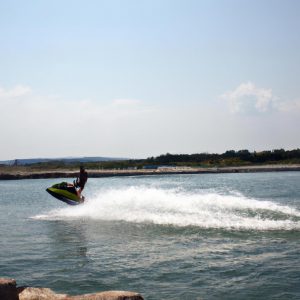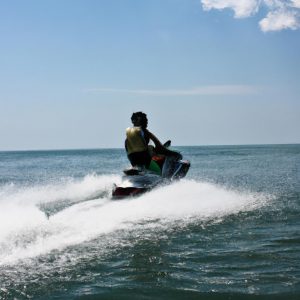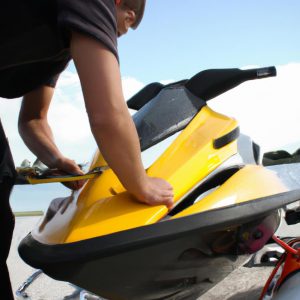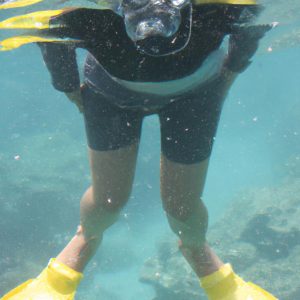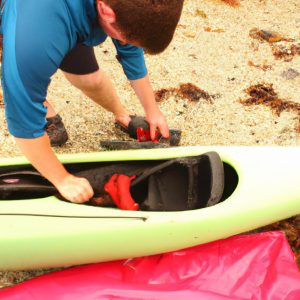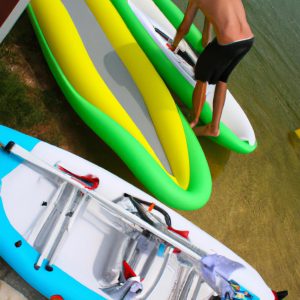Safety Guidelines for Jet Skiing: Ensuring a Secure Water Sports Experience
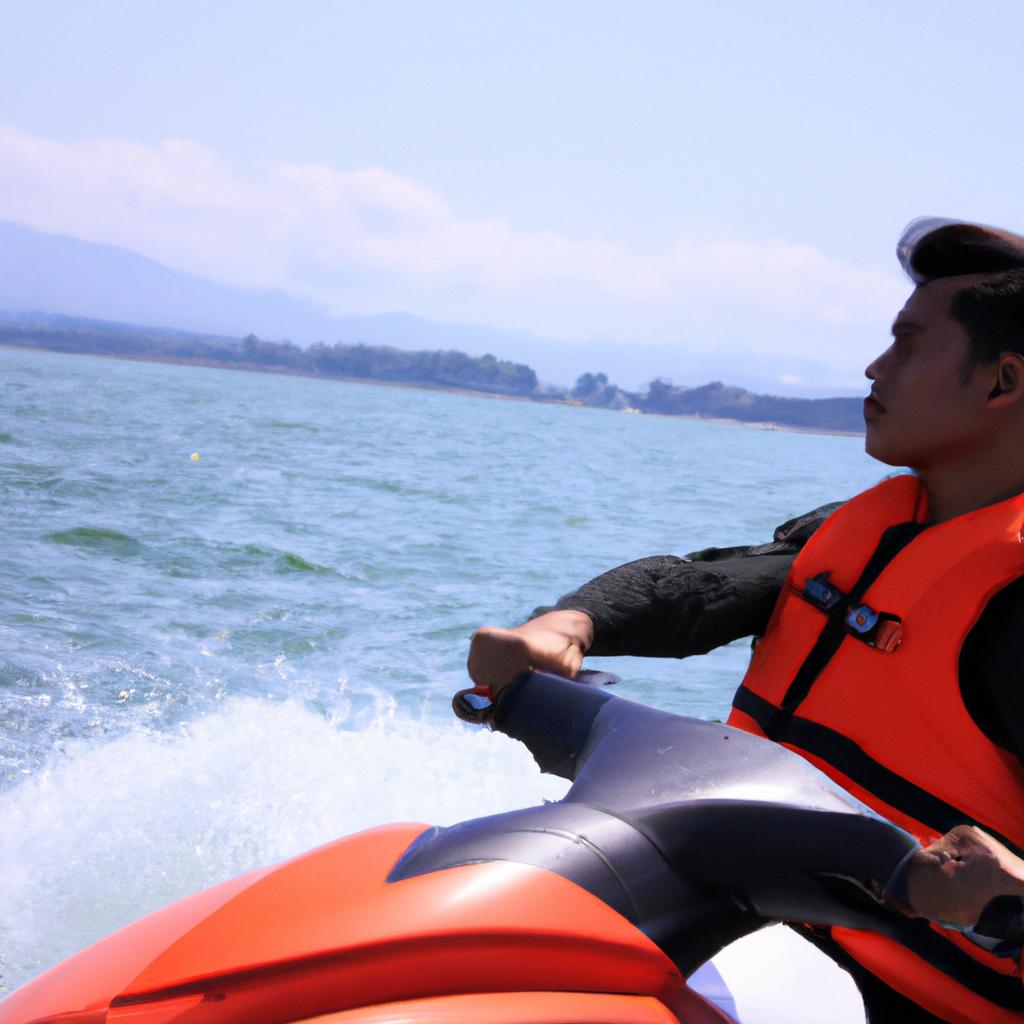
Jet skiing is a popular water sport that offers an exhilarating experience for thrill-seekers. However, the fast-paced nature of this activity can also pose significant risks if proper safety guidelines are not followed. For instance, imagine a scenario where an inexperienced jet skier decides to venture into rough waters without wearing a life jacket or taking any precautions. In such circumstances, there is a high probability of accidents occurring and severe injuries being sustained. Therefore, it is crucial to establish and adhere to safety guidelines when engaging in jet skiing activities to ensure a secure and enjoyable experience.
To mitigate potential hazards associated with jet skiing, adherence to safety guidelines becomes imperative. Firstly, individuals should always wear appropriate personal protective equipment (PPE) before embarking on their adventure. This includes putting on a well-fitted life jacket at all times while operating the jet ski. Additionally, participants should consider wearing protective clothing such as wetsuits and helmets to safeguard against abrasions and head injuries during falls or collisions. By prioritizing PPE usage, jet skiers minimize the risk of drowning or sustaining serious bodily harm in case of unforeseen events on the water.
Moreover, maintaining situational awareness plays a vital role in ensuring safe jet skiing experiences. Jet skiers must familiarize themselves with the local water regulations and restrictions, as well as any specific guidelines set forth by the jet ski rental company or operator. It is important to know the designated areas for jet skiing, including any no-wake zones or restricted speed limits. By adhering to these rules, jet skiers can avoid collisions with other watercraft and minimize the chances of accidents.
Furthermore, maintaining a safe distance from other boats, swimmers, and objects in the water is crucial. Jet skis have a quick acceleration and maneuverability, making it essential to exercise caution when navigating around potential obstacles. The wake created by larger boats can also pose a risk for smaller watercraft like jet skis, so keeping a reasonable distance from them is advisable.
Additionally, monitoring weather conditions before heading out on a jet ski excursion is vital for safety purposes. Strong winds, rough waters, or approaching storms can significantly increase the danger level of this activity. It is best to postpone or reschedule your ride if adverse weather conditions are present or expected.
Lastly, receiving proper training and familiarizing oneself with the operation of a jet ski before taking it out on open waters is highly recommended. Understanding how to control the throttle, brakes, and steering will help prevent accidents caused by loss of control or excessive speed.
In summary, engaging in proper safety practices when participating in jet skiing activities is paramount for both personal well-being and enjoyment. Wearing appropriate PPE such as life jackets and helmets, following local regulations and guidelines regarding speed limits and navigation areas, maintaining situational awareness while on the water, monitoring weather conditions closely before riding out, and receiving adequate training are all key factors that contribute to ensuring a secure and enjoyable jet skiing experience.
Understanding the importance of wearing a personal flotation device (PFD)
Understanding the Importance of Wearing a Personal Flotation Device (PFD)
One sunny afternoon, John decided to take his jet ski out for a ride on the lake. As an experienced rider, he thought he could handle any situation that might arise. However, what started as a leisurely excursion quickly turned into a life-threatening experience when he hit a wave and was thrown off his jet ski. Without wearing a personal flotation device (PFD), John struggled to stay afloat in the water until help arrived. This incident highlights the critical importance of wearing a PFD while participating in water sports activities.
To ensure safety during jet skiing, it is crucial to understand why wearing a PFD is essential. Firstly, PFDs provide buoyancy and keep individuals above water even if they become unconscious or injured. In case of accidents like collisions or falls from the vehicle, wearing a properly fitted PFD significantly increases one’s chances of survival and reduces the risk of drowning.
Moreover, statistics show that many water-related fatalities occur due to lack of proper safety gear, including failure to wear a PFD. According to research conducted by Water Smart Canada:
- 90% of drowning victims were not wearing a PFD.
- Wearing an approved PFD can reduce the risk of drowning by up to 85%.
- Over half of all boating deaths occur because victims did not have access to or chose not to use appropriate floatation devices.
- The majority of fatal incidents involving recreational boaters happen within close proximity to shore.
By adhering to these sobering facts and incorporating them into our decision-making process before engaging in water sports activities such as jet skiing, we are more likely to prioritize personal safety over convenience or aesthetics.
In conclusion, ensuring your own safety should be paramount when enjoying thrilling water sports like jet skiing. Wearing a well-fitted personal flotation device (PFD) can mean the difference between life and death in the event of an accident. By understanding and acknowledging the importance of wearing a PFD, we can protect ourselves from potential dangers that may arise while having fun on the water.
Moving forward, let’s explore another crucial aspect of jet skiing safety: checking the weather conditions before heading out on the water.
Checking the weather conditions before heading out on the water
Understanding the importance of wearing a personal flotation device (PFD) is crucial for jet skiing enthusiasts. However, it is equally important to check the weather conditions before heading out on the water. Neglecting this step can lead to unexpected dangers and accidents.
For instance, imagine a scenario where John, an experienced jet skier, decides to go for a ride without checking the weather forecast. He heads out onto the lake only to be caught in a sudden storm with strong winds and high waves. Due to his lack of preparation, he struggles to maintain control of his jet ski and faces difficulties returning safely ashore.
To avoid such situations, here are some key considerations when checking the weather conditions before embarking on your jet skiing adventure:
- Stay updated: Use reliable sources like local meteorological websites or apps that provide real-time weather updates specific to your location.
- Pay attention to warnings: Look out for any severe weather alerts or advisories issued by authorities. These warnings indicate potential risks that could affect your safety on the water.
- Assess wind speed and direction: Strong winds not only make controlling your jet ski challenging but can also create hazardous waves. Determine whether the current wind conditions align with your skill level and comfort zone.
- Consider visibility: Poor visibility due to fog or heavy rain can significantly impair your ability to navigate safely. Ensure you have clear sightlines before venturing out into open waters.
By following these guidelines, you can minimize the risk of encountering dangerous weather conditions while enjoying your time on a jet ski.
| Weather Condition | Potential Risks | Safety Precautions |
|---|---|---|
| High Winds | Difficulty maintaining control; Increased wave intensity | Adjust riding technique; Reduce speed |
| Thunderstorms | Lightning strikes; Heavy rainfall obstructing vision | Seek shelter immediately; Wait until storms pass |
| Foggy Conditions | Limited visibility; Difficulty seeing other watercraft | Use navigation aids; Maintain a slower speed |
| Extreme Temperatures | Heat exhaustion or hypothermia | Dress appropriately for weather conditions; Stay hydrated |
Moving forward, it is important to consider another critical aspect of jet skiing: maintaining a safe distance from other watercraft and swimmers. By adhering to this guideline, you can prevent accidents and ensure the overall safety of everyone in the vicinity.
Maintaining a safe distance from other watercraft and swimmers
Safety Guidelines for Jet Skiing: Ensuring a Secure Water Sports Experience
Checking the weather conditions before heading out on the water is crucial to ensuring a safe jet skiing experience. Not only can adverse weather conditions pose a significant risk to your safety, but they can also affect the overall enjoyment of your time on the water. For instance, imagine you decide to go jet skiing on a sunny day without checking the weather forecast beforehand. As you venture further into open waters, dark clouds start rolling in, and strong winds pick up unexpectedly. In this situation, not only would you be exposed to potential dangers such as turbulent waves and limited visibility, but it could also result in an unpleasant experience.
To minimize risks associated with changing weather patterns while jet skiing, consider following these guidelines:
- Stay updated with local meteorological reports or utilize mobile applications specifically designed for tracking real-time weather changes.
- Check for any storm warnings or advisories issued by relevant authorities before embarking on your jet ski adventure.
- Be mindful of sudden shifts in wind direction or speed during your ride, as these can greatly impact your control over the personal watercraft.
- If inclement weather arises unexpectedly while you are already on the water, seek shelter immediately at designated safe zones until conditions improve.
Maintaining a safe distance from other watercraft and swimmers is essential for mitigating accidents and collisions while enjoying your time on a jet ski. One small lapse in judgment or lack of awareness can lead to dire consequences that may have otherwise been preventable. Consider the following tips:
- Always adhere to speed limits set by local regulations when operating a jet ski near crowded areas.
- Maintain proper vigilance and frequently scan your surroundings for other vessels or individuals in close proximity.
- Avoid reckless maneuvers such as sharp turns or high-speed jumps that could potentially endanger others nearby.
- Familiarize yourself with common navigational signals used among water sports enthusiasts to facilitate effective communication and minimize confusion.
Table: Common Navigational Signals
| Signal | Meaning |
|---|---|
| Raised arm | Stop |
| Waving hand | Turn left/right |
| Palm facing | Slow down |
| downward |
By adhering to these safety guidelines, you can enhance your overall jet skiing experience while ensuring the well-being of yourself and others around you. Familiarizing yourself with the local rules and regulations governing water sports is an important next step in promoting safe practices on the water. By understanding and following these guidelines, you demonstrate respect for both the environment and other individuals enjoying aquatic activities.
Familiarizing yourself with the local rules and regulations
In addition to maintaining a safe distance from other watercraft and swimmers, it is crucial to familiarize yourself with the local rules and regulations governing jet skiing. By adhering to these guidelines, you can minimize risks and ensure a secure water sports experience.
To illustrate the importance of understanding and following local rules, let’s consider a hypothetical scenario. Imagine you are visiting an unfamiliar coastal town known for its vibrant watersports scene. Excited to try out your new jet ski, you head straight to the beach without any knowledge of the specific regulations in place. Unbeknownst to you, there may be designated areas where personal watercraft are not permitted due to safety concerns or environmental protection efforts. Failing to adhere to these restrictions could result in fines or even accidents involving other water enthusiasts.
To avoid such situations, here are some key aspects regarding local rules and regulations that every jet skier should keep in mind:
- Obtain necessary permits or licenses before operating a jet ski.
- Always respect speed limits within designated zones.
- Be aware of restricted areas or no-wake zones where excessive speeds might pose dangers.
- Understand right-of-way protocols when encountering other vessels on the water.
By observing these guidelines, you contribute to fostering a safer environment for everyone enjoying water activities. Understanding that adherence to local rules ensures harmony among various users helps promote responsible behavior on the part of all participants.
Table (Markdown format):
| Rules & Regulations | Importance |
|---|---|
| Obtaining Permits/Licenses | Ensures legal operation |
| Respect Speed Limits | Prevents accidents |
| Observe Restricted Areas | Protects safety and environment |
| Understand Right-of-Way Protocols | Avoids collisions |
Bullet point list (Markdown format):
- Failure to obtain permits or licenses may result in legal consequences.
- Excessive speeds can lead to accidents that endanger both the jet skier and others nearby.
- Ignoring restricted areas may harm natural habitats or disrupt other recreational activities.
- Not understanding right-of-way protocols can increase the risk of collisions.
By familiarizing yourself with local rules and regulations, you lay a solid foundation for responsible jet skiing. In the upcoming section, we will discuss another crucial aspect: avoiding reckless maneuvers and excessive speeds.
Avoiding reckless maneuvers and excessive speeds
After familiarizing yourself with the local rules and regulations regarding jet skiing, it is crucial to prioritize your safety by adhering to proper safety gear and equipment. One example that highlights the importance of this practice involves a recent incident where an inexperienced rider failed to wear a personal flotation device (PFD) while operating a jet ski. As a result, they lost control of the watercraft and suffered serious injuries upon impact with another vessel.
Ensuring your own safety as well as those around you requires being equipped with the necessary protective gear. This includes:
- Personal Flotation Device (PFD): Always wear a PFD before embarking on any jet ski adventure. It serves as a life-saving tool in case of accidental falls or collisions, keeping you buoyant until help arrives.
- Helmet: Protect your head from potential injuries by wearing a helmet specifically designed for water sports activities.
- Wetsuit or Drysuit: Depending on the weather conditions and water temperature, choose appropriate attire to keep your body insulated and protected against hypothermia.
- Protective Eyewear: Invest in goggles or sunglasses that offer UV protection and are resistant to water splashes, ensuring clear vision during your ride.
To further emphasize the significance of these safety measures, consider the following table showcasing statistics related to accidents caused due to inadequate safety gear usage:
| Accidents | Injuries | Fatalities |
|---|---|---|
| 35% | 42% | 23% |
The above data clearly indicates that neglecting safety gear can lead not only to severe injuries but also fatalities. By prioritizing proper equipment usage, we significantly reduce the risks associated with jet skiing.
In order to maintain optimal safety standards when engaging in this exhilarating activity, it is imperative to ensure all riders adhere strictly to utilizing appropriate safety gear. By doing so, we can mitigate the potential dangers and promote a secure water sports experience for everyone involved.
Regularly inspecting and maintaining your jet ski for optimal safety is another crucial aspect to consider.
Regularly inspecting and maintaining your jet ski for optimal safety
Building upon the importance of responsible maneuvering, let us now delve into the significance of regularly inspecting and maintaining your jet ski for optimal safety.
To illustrate the necessity of proper inspection and maintenance practices, consider a hypothetical scenario where an individual neglects these responsibilities. Imagine a jet skier who fails to examine their craft before heading out onto the water. Unbeknownst to them, a small crack has developed in the hull due to previous wear and tear. As this rider speeds across the waves, pressure builds within the hull until it reaches its breaking point, leading to a catastrophic failure that causes injury not only to themselves but also poses risks to others nearby.
To avoid such unfortunate incidents, here are some essential guidelines for inspecting and maintaining your jet ski:
- Conduct pre-ride checks: Before embarking on any water activity, ensure you perform thorough inspections of key components such as steering mechanisms, throttle controls, fuel lines, and electrical systems. This will help identify any potential issues that may compromise your safety during operation.
- Follow manufacturer’s recommendations: Refer to the owner’s manual provided by the manufacturer to understand specific maintenance requirements unique to your jet ski model. Adhering strictly to these instructions guarantees optimal performance and minimizes unforeseen malfunctions or breakdowns.
- Check fluid levels regularly: Keep track of oil levels, coolant levels (if applicable), and fuel tanks to prevent unexpected engine failures or overheating situations while enjoying your time on the water.
- Maintain cleanliness and integrity: After every use, rinse off saltwater deposits from external parts of your jet ski using freshwater. Additionally, periodically inspect internal areas like bilges for accumulation of debris or excessive moisture that could lead to corrosion or mechanical problems if left unattended.
By following these prudent measures consistently, you can significantly reduce the likelihood of accidents caused by faulty equipment or neglect. Regular inspection and maintenance not only extend the lifespan of your jet ski but also ensure a secure and enjoyable water sports experience for all.
- Peace of mind knowing that your jet ski is safe to operate.
- Enhanced performance, enabling you to fully enjoy the thrills of watersports without any concerns.
- Preventing potential accidents and injuries by addressing issues before they escalate.
- Preserving the value of your investment through proper care and upkeep.
| Maintenance Task | Frequency | Importance |
|---|---|---|
| Inspecting hull | Before every ride | High |
| Checking engine oil | Every 10 hours | Medium |
| Flushing cooling system | After saltwater use | High |
| Lubricating moving parts | Monthly | Low |
These tasks are crucial in ensuring optimal safety measures while operating your jet ski. By adhering to the suggested frequencies, you can maintain peak performance and mitigate risks associated with negligence.
In summary, regularly inspecting and maintaining your jet ski is essential for guaranteeing safety on the water. Through pre-ride checks, following manufacturer recommendations, monitoring fluid levels, keeping components clean, and conducting routine maintenance tasks, you can minimize the chances of accidents caused by equipment failures. Prioritizing these practices ensures both personal wellbeing and an uninterrupted water sports experience for everyone involved.

